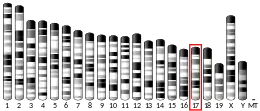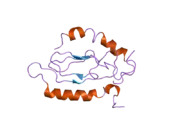Pituitary adenylate cyclase-activating peptide
Pituitary adenylate cyclase-activating polypeptide also known as PACAP is a protein that in humans is encoded by the ADCYAP1 gene.[5][6] PACAP is similar to vasoactive intestinal peptide. One of its effects is to stimulate enterochromaffin-like cells. It binds to vasoactive intestinal peptide receptor and to the PACAP receptor.
Function
This gene encodes adenylate cyclase-activating polypeptide 1. Mediated by adenylate cyclase-activating polypeptide 1 receptors, this polypeptide stimulates adenylate cyclase and subsequently increases the cAMP level in target cells. Adenylate cyclase-activating polypeptide 1 not only is a hypophysiotropic hormone (i.e. a substance that induces activity in the hypophysis), but also functions as a neurotransmitter and neuromodulator. In addition, it plays a role in paracrine and autocrine regulation of certain types of cells. This gene is composed of five exons. Exons 1 and 2 encode the 5' UTR and signal peptide, respectively; exon 4 encodes an adenylate cyclase-activating polypeptide 1-related peptide; and exon 5 encodes the mature peptide and 3' UTR. This gene encodes three different mature peptides, including two isotypes: a shorter form and a longer form.[6]
A version of this gene has been associated with post-traumatic stress disorder (PTSD) in women (but not men).[7] This disorder involves a maladaptive psychological response to traumatic, i.e. existence-threatening, events. Ressler et al. identified an association of a SNP in the gene coding for pituitary adenylate cyclase-activating polypeptide (PACAP), implicating this peptide and its receptor (PAC1) in PTSD.
Headache Disorders
Research has shown that administration of intravenous PACAP-38 (two species of PACAP have been identified, one that is 38 amino acids long and one that is 27 amino acids long) triggers delayed "migraine-like headaches" in most subjects who experience migraine headaches.[8] Treatments with monoclonal antibodies are being developed targeting PACAP or its receptors for the treatment of primary headache disorders. These include: AMG‐301 developed by Amgen Inc., which targets the PAC1 receptor and has completed phase II trials; and ALD1910, developed by Alder BioPharmaceuticals, which targets the peptide and began a phase I study in October 2019.[9][10]
Interactions
Pituitary adenylate cyclase-activating peptide has been shown to interact with secretin receptor.[11]
See also
References
- GRCh38: Ensembl release 89: ENSG00000141433 - Ensembl, May 2017
- GRCm38: Ensembl release 89: ENSMUSG00000024256 - Ensembl, May 2017
- "Human PubMed Reference:". National Center for Biotechnology Information, U.S. National Library of Medicine.
- "Mouse PubMed Reference:". National Center for Biotechnology Information, U.S. National Library of Medicine.
- Hosoya M, Kimura C, Ogi K, Ohkubo S, Miyamoto Y, Kugoh H, Shimizu M, Onda H, Oshimura M, Arimura A, et al. (Feb 1992). "Structure of the human pituitary adenylate cyclase activating polypeptide (PACAP) gene". Biochim Biophys Acta. 1129 (2): 199–206. doi:10.1016/0167-4781(92)90488-l. PMID 1730060.
- "Entrez Gene: ADCYAP1 adenylate cyclase activating polypeptide 1 (pituitary)".
- Ressler, KJ; Mercer, KB; Bradley, B; Jovanovic, T; Mahan, A; Kerley, K; Norrholm, SD; Kilaru, V; Smith, AK; Myers, AJ; Ramirez, M; Engel, A; Hammack, SE; Toufexis, D; Braas, KM; Binder, EB; May, V (Feb 24, 2011). "Post-traumatic stress disorder is associated with PACAP and the PAC1 receptor". Nature. 470 (7335): 492–7. Bibcode:2011Natur.470..492R. doi:10.1038/nature09856. PMC 3046811. PMID 21350482.
- Waschek, James A.; Baca, Serapio M.; Akerman, Simon (2018). "PACAP and migraine headache: immunomodulation of neural circuits in autonomic ganglia and brain parenchyma". The Journal of Headache and Pain. 19 (1): 23. doi:10.1186/s10194-018-0850-6. ISSN 1129-2369. PMC 5849772. PMID 29536279.
- Bertels, Zachariah; Pradhan, Amynah Amir Ali (2019). "Emerging Treatment Targets for Migraine and Other Headaches". Headache: The Journal of Head and Face Pain. 59 (S2): 50–65. doi:10.1111/head.13585. ISSN 0017-8748. PMC 6986366. PMID 31291018.
- "Alder BioPharmaceuticals® Announces First-in-Human Dosing in Phase 1 ALD1910 Study for Preventive Treatment of Migraine". GlobeNewswire. 10 October 2019. Retrieved 10 October 2019.
- Felley, C P; Qian J M; Mantey S; Pradhan T; Jensen R T (Dec 1992). "Chief cells possess a receptor with high affinity for PACAP and VIP that stimulates pepsinogen release". Am. J. Physiol. UNITED STATES. 263 (6 Pt 1): G901–7. doi:10.1152/ajpgi.1992.263.6.G901. ISSN 0002-9513. PMID 1335692.
Further reading
- Conconi MT, Spinazzi R, Nussdorfer GG (2006). "Endogenous ligands of PACAP/VIP receptors in the autocrine-paracrine regulation of the adrenal gland". Int. Rev. Cytol. International Review of Cytology. 249: 1–51. doi:10.1016/S0074-7696(06)49001-X. ISBN 9780123646538. PMID 16697281.
- Cross SH, Charlton JA, Nan X, Bird AP (1994). "Purification of CpG islands using a methylated DNA binding column". Nat. Genet. 6 (3): 236–44. doi:10.1038/ng0394-236. PMID 8012384. S2CID 12847618.
- Dautzenberg FM, Mevenkamp G, Wille S, Hauger RL (2000). "N-terminal splice variants of the type I PACAP receptor: isolation, characterization and ligand binding/selectivity determinants". J. Neuroendocrinol. 11 (12): 941–9. doi:10.1046/j.1365-2826.1999.00411.x. PMID 10583729. S2CID 35761617.
- Fahrenkrug J (2002). "Gut/brain peptides in the genital tract: VIP and PACAP". Scand. J. Clin. Lab. Invest. Suppl. 61 (234): 35–9. doi:10.1080/003655101317095392. PMID 11713978. S2CID 7249967.
- Fahrenkrug J (2006). "PACAP--a multifacetted neuropeptide". Chronobiol. Int. 23 (1–2): 53–61. doi:10.1080/07420520500464569. PMID 16687279. S2CID 29584195.
- Felley CP, Qian JM, Mantey S, et al. (1993). "Chief cells possess a receptor with high affinity for PACAP and VIP that stimulates pepsinogen release". Am. J. Physiol. 263 (6 Pt 1): G901–7. PMID 1335692.
- Geng L, Ju G (2000). "[The discovery of pituitary adenylate cyclase activating polypeptide (PACAP) and its research progress]". Sheng li ke xue jin zhan [Progress in physiology]. 28 (1): 29–34. PMID 10921074.
- Gourlet P, Vandermeers A, Robberecht P, Deschodt-Lanckman M (1997). "Vasoactive intestinal peptide (VIP) and pituitary adenylate cyclase-activating peptide (PACAP-27, but not PACAP-38) degradation by the neutral endopeptidase EC 3.4.24.11". Biochem. Pharmacol. 54 (4): 509–15. doi:10.1016/S0006-2952(97)00207-4. PMID 9313778.
- Inagaki N, Yoshida H, Mizuta M, et al. (1994). "Cloning and functional characterization of a third pituitary adenylate cyclase-activating polypeptide receptor subtype expressed in insulin-secreting cells". Proc. Natl. Acad. Sci. U.S.A. 91 (7): 2679–83. Bibcode:1994PNAS...91.2679I. doi:10.1073/pnas.91.7.2679. PMC 43433. PMID 8146174.
- Inooka H, Endo S, Kitada C, et al. (1993). "Pituitary adenylate cyclase activating polypeptide (PACAP) with 27 residues. Conformation determined by 1H NMR and CD spectroscopies and distance geometry in 25% methanol solution". Int. J. Pept. Protein Res. 40 (5): 456–64. doi:10.1111/j.1399-3011.1992.tb00324.x. PMID 1483839.
- Kimura C, Ohkubo S, Ogi K, et al. (1990). "A novel peptide which stimulates adenylate cyclase: molecular cloning and characterization of the ovine and human cDNAs". Biochem. Biophys. Res. Commun. 166 (1): 81–9. doi:10.1016/0006-291X(90)91914-E. PMID 2302217.
- Nakata M, Yada T (2007). "PACAP in the glucose and energy homeostasis: physiological role and therapeutic potential". Curr. Pharm. Des. 13 (11): 1105–12. doi:10.2174/138161207780618948. PMID 17430174.
- Ohkubo S, Kimura C, Ogi K, et al. (1992). "Primary structure and characterization of the precursor to human pituitary adenylate cyclase activating polypeptide". DNA Cell Biol. 11 (1): 21–30. doi:10.1089/dna.1992.11.21. PMID 1739432.
- Ohtaki T, Masuda Y, Ishibashi Y, et al. (1994). "Purification and characterization of the receptor for pituitary adenylate cyclase-activating polypeptide". J. Biol. Chem. 268 (35): 26650–7. PMID 8253796.
- Pérez-Jurado LA, Francke U (1993). "Dinucleotide repeat polymorphism at the human pituitary adenylate cyclase activating polypeptide (PACAP) gene". Hum. Mol. Genet. 2 (6): 827. doi:10.1093/hmg/2.6.827-a. PMID 8353512.
- Vaudry D, Falluel-Morel A, Bourgault S, Basille M, Burel D, Wurtz O, Fournier A, Chow BK, Hashimoto H, Galas L, Vaudry H (2009). "Pituitary adenylate cyclase-activating polypeptide and its receptors: 20 years after the discovery". Pharmacol. Rev. 61 (3): 283–357. doi:10.1124/pr.109.001370. PMID 19805477. S2CID 5739004.
- Waschek JA (2002). "Multiple actions of pituitary adenylyl cyclase activating peptide in nervous system development and regeneration". Dev. Neurosci. 24 (1): 14–23. doi:10.1159/000064942. PMID 12145407. S2CID 22281905.
- Weber B, Riess O, Daneshvar H, et al. (1993). "(CA)n-dinucleotide repeat at the PDEB locus in 4p16.3". Hum. Mol. Genet. 2 (6): 827. doi:10.1093/hmg/2.6.827. PMID 8394765.
- Wray V, Kakoschke C, Nokihara K, Naruse S (1993). "Solution structure of pituitary adenylate cyclase activating polypeptide by nuclear magnetic resonance spectroscopy". Biochemistry. 32 (22): 5832–41. doi:10.1021/bi00073a016. PMID 8504103.
- Zeng N, Athmann C, Kang T, et al. (1999). "PACAP type I receptor activation regulates ECL cells and gastric acid secretion". J. Clin. Invest. 104 (10): 1383–91. doi:10.1172/JCI7537. PMC 409843. PMID 10562300.
External links
- Pituitary+adenylate+cyclase-activating+polypeptide at the US National Library of Medicine Medical Subject Headings (MeSH)
This article incorporates text from the United States National Library of Medicine, which is in the public domain.







